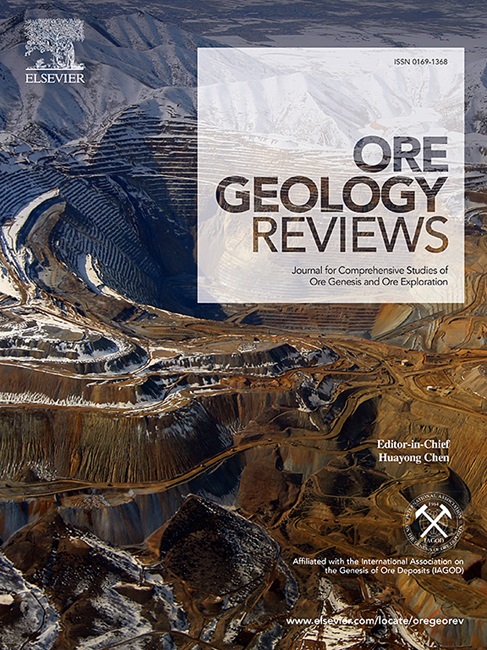Detecting mineralization via white mica spectral footprints: From field-based sampling to satellite hyperspectral remote sensing
IF 3.2
2区 地球科学
Q1 GEOLOGY
引用次数: 0
Abstract
The utilization of shortwave infrared (SWIR) spectroscopy serves as a potent technique in mineral identification and hydrothermal alteration mapping, and spectral characteristics of some altered minerals have been indicators for targeting porphyry-epithermal deposits. Its application relies on acquiring ground/lab spectral data from surface and/or drill hole samples, with potential satellite remote sensing applications remaining more effort. In this study, the Duolong mineral district served as the test area for alteration mapping, spectral characterization, and mineral exploration. A spectral feature parameterization method and an exploration indication model were proposed based on the SWIR spectra and Gaofen-5 (GF-5) hyperspectral images. The results showed that the hydrothermally altered minerals in the Duolong mineral district are mainly composed of white mica, kaolinite, and chlorite, with minor amounts of sulphate and carbonate. The minerals exhibited characteristic alteration zoning patterns commonly observed in porphyry Cu systems, and there is a clear overlap between the zones. SWIR analysis conducted in the Gaerqin deposit, specifically revealed the spatial variation of both the position (Pos2200) and depth (Dep2200) of the Al-OH absorption feature in white mica surrounding the granodiorite porphyry. That is, the shorter Pos2200 (< 2203 nm) and higher Dep2200 (> 0.32) of white mica in the surface ring zone, the closer to the center. Meanwhile, the support vector regression (SVR) method was used to construct a deposit-scale spectral feature-based exploration indication model for white mica, incorporating the Pos2200 and Dep2200 parameters. Based on the spatial distribution of white mica derived from GF-5 imagery, this model facilitated the prediction of potential hydrothermal and/or mineralization centers, showing good correspondence with the known locations of magmatic rocks and ore deposits in the Duolong mineral district. This study demonstrates that integrating satellite remote sensing and mineral spectral measurement not only reveals the significance of white mica spectral footprints but also enhances the accuracy and convenience of remote sensing mineral exploration prospecting, thereby providing novel insights for future mineral exploration.

通过白云母光谱足迹探测矿化:从野外采样到卫星高光谱遥感
短波红外光谱技术在矿物识别和热液蚀变填图中具有重要的应用价值,一些蚀变矿物的光谱特征已成为寻找斑岩浅成热液矿床的标志。它的应用依赖于从地面和/或钻孔样本中获取地面/实验室光谱数据,潜在的卫星遥感应用还需要更多的努力。本研究将多龙矿区作为蚀变填图、光谱表征和找矿的试验区。提出了基于SWIR光谱和高分5号高光谱图像的光谱特征参数化方法和勘探指示模型。结果表明:多龙矿区热液蚀变矿物以白云母、高岭石、绿泥石为主,含少量硫酸盐和碳酸盐;这些矿物表现出斑岩型铜系统中常见的蚀变分带特征,各分带之间有明显的重叠。通过对喀尔沁矿床的SWIR分析,具体揭示了花岗闪长斑岩周围白色云母中Al-OH吸收特征的位置(Pos2200)和深度(Dep2200)的空间变化。即较短的Pos2200 (<;2203 nm)和更高的Dep2200 (>;0.32)的白色云母在表面环带,越靠近中心。同时,利用支持向量回归(SVR)方法,结合Pos2200和Dep2200参数,构建了基于矿床尺度光谱特征的白云母勘探指示模型。基于GF-5影像获取的白云母空间分布特征,该模型对多龙矿区潜在热液和成矿中心进行了预测,与多龙矿区已知岩浆岩和矿床位置具有较好的对应关系。研究表明,卫星遥感与矿物光谱测量相结合,不仅揭示了白云母光谱足迹的重要意义,而且提高了遥感矿产勘查的准确性和便捷性,为今后的矿产勘查提供了新的思路。
本文章由计算机程序翻译,如有差异,请以英文原文为准。
求助全文
约1分钟内获得全文
求助全文
来源期刊

Ore Geology Reviews
地学-地质学
CiteScore
6.50
自引率
27.30%
发文量
546
审稿时长
22.9 weeks
期刊介绍:
Ore Geology Reviews aims to familiarize all earth scientists with recent advances in a number of interconnected disciplines related to the study of, and search for, ore deposits. The reviews range from brief to longer contributions, but the journal preferentially publishes manuscripts that fill the niche between the commonly shorter journal articles and the comprehensive book coverages, and thus has a special appeal to many authors and readers.
 求助内容:
求助内容: 应助结果提醒方式:
应助结果提醒方式:


